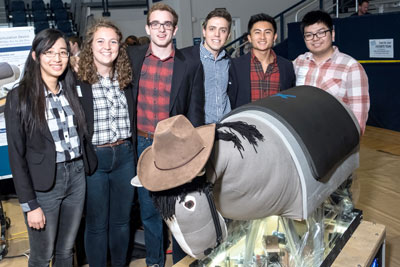MECHANICAL HORSE FOR HIPPOTHERAPY...

Saddle up on this robot horse and you could help improve your coordination, balance and strength.
Powered by electronics, he moves like a real horse.
View the video
Nicknamed Stewie, the robot was designed and built by senior mechanical engineering students Kelsi Wicker, Sebastian Jia, Matthew O'Gorman, James Phillips, Wesley Yee and Jijie Zhou attending Rice University, located in Houston, Texas.
Stewie was created specifically to aid people undergoing hippotherapy -- the use of horseback riding as a rehabilitative treatment for patients seeking to improve their movement and balance capabilities. Hippotherapy is also used to help kids with speech problems. It is also used to improve the coordination, balance, and core strength of patients with autism, cerebral palsy, and other disorders.
Unfortunately, hippotherapy is inaccessible to many patients because of its high price per session and the remote location of therapy centers. To provide an affordable, readily available alternative to patients, students at Rice University built a mechanical hippotherapy device that simulates the motion of a horse and the experience of controlling a horse.
The design includes a realistic back, a working rein mechanism, and a moving head to make using the device feel like riding a horse. The device also performs two different horse gaits, walk and trot, to closely approximate the motion of a real horse.
In addition, the students installed a variety of safety features, such as emergency stop mechanisms and a harness, to make the device safe, and a touchscreen to make the device easy to use. They envision the product to be used both in clinical and residential settings to make hippotherapy available to a wider range of patients.
The engineering students say Stewie is more controllable and comfortable for riders who don't have access to real horses. Stewie can accommodate a 250-pound (113 kg) rider, and can theoretically hold up to 500 pounds (227 kg) of weight.
Stewie is based on a robotic concept invented back in the 1950s called the Stewart platform, which uses six computer-controlled motors attached to metal legs to allow for six degrees of movement: latitude, longitude, vertical, pitch, roll and yaw (twisting on a vertical axis).
"It's similar to what you would see on flight simulators at NASA," Yee said in a statement from Rice University.
In a video posted Wednesday, Stewie's creators explain the basics of how they built and tested the gadget.
The students fine-tuned the robot horse's movements by using a phone app to collect data and then incorporating that into their code. Patients and therapists can determine the kind and length of a ride.
"We can enter any position and orientation at any time, and this allows us to re-create any horse gait," O'Gorman says in the video. "Hippotherapists will choose the horse based on the needs of the patient, and different horses will offer different gaits. We're able to reproduce many different gaits with our system because it relies on electrical controls rather than mechanical controls."
Stewie's design schematics and codes are open-source and will be available free online to those who want to build and improve on the original robot horse.
|